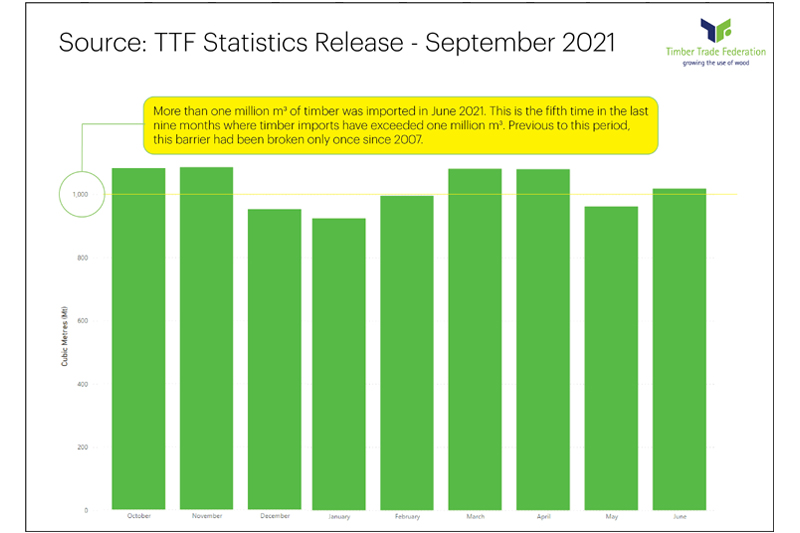
The latest statistics from the Timber Trade Federation (TTF) show the volume of imported timber experienced a further surge in June 2021, exceeding one million m3.
Timber imports have rarely exceeded one million m3 per month, however, this latest data reveals June to be the fifth time this barrier was broken across Q4 2020 and Q2 2021. And at a total of 1.01 million m3, this brings the total volume of imports to more than 6 million m3 in the first six months of 2021 – the highest since 2007.
Prior to this, timber imports had exceeded one million m3 just once in the past four years – in January 2019 – which was spurred by Brexit stockpiling. Import volumes in Q2 2021 were overall 60% higher than the same quarter in 2020 – which was the worst affected months of the first lockdown.
Supplying countries have seen significant change, with the four leading softwood supplying countries exporting over one million m3 more in the first half of 2021. Sweden, Finland, and Latvia have each supplied an additional 300,000m3, whilst ‘smaller’ countries such as Lithuania and Austria have also recorded growth rates of over 200%.
David Hopkins, CEO of the Timber Trade Federation (TTF), said: “The timber industry has seen a period of unprecedented demand driven by a resurgent construction industry as people invest into the places they have spent the past 18 months – their homes.
“The supply chain has been working hard to satisfy this additional demand, which is expected to continue in the short to medium term according to industry forecasts. While some of this demand may ease as pandemic restrictions subside, the demand for timber is likely to remain strong amidst a construction industry seeking to rapidly decarbonise”
He continued: “By choosing to build with responsibly sourced timber, architects, engineers and house builders are helping to turn our built environment into a form of carbon capture and storage. There is a significant opportunity for the timber sector to grow into a pillar of the UK’s low-carbon economy.
“The main brake on this growth will come from other factors, particularly labour shortages in areas across the supply chain from logistics to skilled on-site labour, with the CBI warning this could take at least two years to settle down.”
More information on timber supply can be found on the TTF Statistics Hub.
To help shed greater light on the state of the timber market, the Confederation of Timber Industries released a Market Statement on 21 July to put the current demand and supply situation into context. The TTF says: “We recommend reading this, which goes into far greater detail into why current events are unfolding”.









